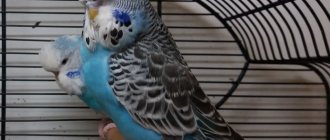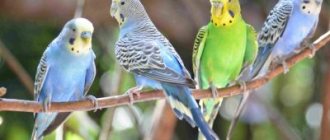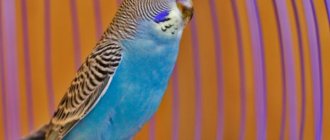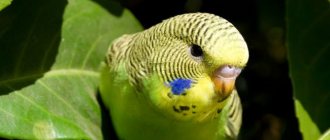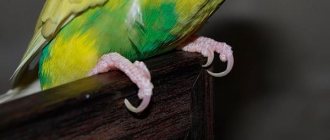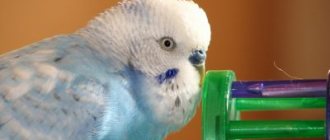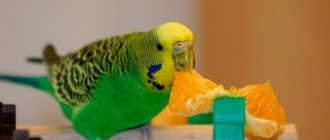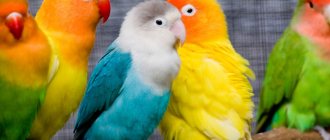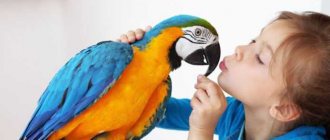Small cage and aviary
The ring-necked parrot is considered one of the most unpretentious birds that can be kept at home. But this does not mean that nothing at all is required from the owner. The first thing he must do is prepare a home for the pet, that is, a cage and an enclosure for walking.
The minimum cage size for one parrot is 0.7 m in height and 0.5 m in width and length. But this is not the best option. In such a small house, the pet will only be able to eat and sleep. But he needs to move. To do this, you need to additionally have an aviary. It is a platform with a fixed stand, where perches are placed and feeders are fixed.
You can limit the flight distance using a special leash or chain. You need to take your parrot for a walk every day so that the pet exercises its muscles in movement.
Determination of gender
Up to 3 years of age, gender can only be determined with 100% accuracy using a special analysis. There are several indirect ways to distinguish a boy chick from a girl. A few words need to be said about each of them.
By color and dark ring around the neck
Females are more dull in color. They do not have a “necklace” - a black and pink stripe around the neck.
According to the shape and size of the head, beak
The head of females is more rounded than that of males. The latter are also distinguished by a more saturated color of the cheeks and beak.
By the paws
The paws of female chicks are slightly more powerful and larger than the paws of males. The legs of female birds themselves are somewhat thicker and shorter than those of male chicks.
Tail length
The tail of a male pet is usually slightly longer than that of a female.
By behavior
You need to place a small mirror in the cage and watch your pet. Males, seeing their reflection, begin to show beauty - they constrict their pupils and open their wings. Female chicks behave differently - they tilt their heads back and constrict their pupils in the same way.
Laboratory DNA test
One of all, giving an accurate result. The probability of error is 0.1%. For analysis, it is not necessary to remove the necklace chick from the cage and take the chick to the laboratory. Simply providing a few pet feathers is enough.
The necklace parrot is a very interesting species of bird. Its representatives can be successfully kept in a home cage.
Previous
All typesThe most expensive parrots in the world
Next
All types of Azure parrot and its features
Attention and communication
If you purchase a large cage, it will also be suitable as an aviary where your pet can fly. Good size: width - 0.6 m, length - 1 m, height - 1.2 m. Choose a cage with horizontal bars, then it will be more convenient for the parrot to cling to them.
It takes a new resident some time to get comfortable. This will take three to four days. After this, begin to teach the parrot to take food from your hand. Slowly and carefully, you need to stick your hand with a treat into the cage and wait patiently for the pet to take it.
Each time you need to place your palm further away from the parrot. As a result, he will be forced to sit on your hand to peck at the treat. At the same time, you need to talk to him quietly and gently, at the same time giving him the opportunity to get used to human speech.
These actions are a mandatory process in creating comfortable living conditions for the necklace parrot, which requires daily communication.
How to make friends with a chick and an adult
When a young parrot gets into a new family, there are no problems with getting used to it. The ideal age for taming is 5-6 months. Feeding, conversation, tactile contact - all this brings the owner and his pet closer together. In a week, the chick will already feel like a full member of the family. The main thing is to communicate and devote several hours of your free time a day to the bird.
It is more difficult to tame an adult. At first she will be completely wild, it will be difficult to establish contact.
You cannot let a wild bird out of its cage; it is almost impossible to drive it back. He will think that he will never get free again, and will not let himself be grabbed, and may even bite painfully. The new owner will despair if he does not find a way to tame the necklace parrot. There are simple rules that always work.
- Stay close as often as possible. You need to speak to your pet in a quiet, gentle voice. You can reach out to the cage and freeze for a minute, then gently move your fingers. The bird will gradually get used to the proximity of human hands. If your pet is not frightened by your body movements, you can open the cage and extend your hand to him, trying not to frighten him away. Only after the bird gets used to the human hand can you proceed to the next step.
- Hand feeding. As soon as the parrot stops being indignant about the invasion of his home, you can offer him a treat. It’s good to put your favorite fruit or nut in your palm and slowly extend your hand to her. If your pet is still afraid of its new owner, you can feed it through the bars of the cage. The bird will gradually learn to trust the person and will begin to eat from his hand.
- The bird is then taught to sit on the hand while feeding. As soon as she stops being afraid of the outstretched hand, they begin to move their fingers and try to remove the hand from the cage. The parrot will not like this, and in order to get the treat, he will begin to sit on the palm.
- The next step is to taming the parrot to the space outside the cage. As soon as he sits on the hand, they slowly begin to carry him out of the expanses of the bird’s home. At the same time, they talk to the feathered animal gently and quietly. There should be no loud noises, animals, or children in the house that would frighten him.
All stages take place only in this sequence. Lessons are held several times a day. For each completed task, the bird should receive a treat and verbal praise. Once the necklace parrot has been tamed and begins to trust its owner, it can be released from its cage and allowed to explore the human home.
Four ways to bathe
Organization of bathing is very important in the process of caring for a necklace parrot. There are several ways to do this. You can use a spray bottle and spray your pet through the bars of the cage. The second method is when a special bath filled with water is placed inside. Third, the cage with the parrot is taken into the bathroom and watered with a shower. And finally, aerobatics: the parrot is transferred to the bathroom without a cage (on his arm) and takes a shower with pleasure.
Your pet must be accustomed to any of the proposed methods and done with extreme caution so as not to permanently turn him away from water procedures. After all, they are very beneficial for health, help maintain good plumage, and when properly tamed, they bring true pleasure to the necklace parrot.
Cleanliness and hygiene are important components of care, so do not forget to not only bathe your pet, but also clean his cage daily.
General information about the breed
The homeland of the necklace parrot, which is also called the Indian ringed parrot, is Africa and Asia. Such birds are considered the most numerous breed of parrots. Birds live in large flocks, and usually settle near human habitations. Even in ancient times, monks were engaged in taming necklace parrots, since having such a bird at home was considered prestigious.
Now parrots are found in the wild in Australia, and numerous flocks live in Madagascar. This breed is found even in Europe, mainly in England.
The characteristics of the birds include:
different breeds of necklace parrots have a similar appearance, but differ slightly in body size and plumage colors;- the birds are small in size, so their body length varies from 30 to 60 cm;
- most of the body is occupied by a stepped tail;
- the wingspan reaches 16 cm, and the weight of the bird is from 115 to 150 grams;
- Usually parrots have green or yellow colors, and there are also other bright shades, thanks to which the bird is easily camouflaged among the foliage, but breeders prefer to breed brighter or unusual colors;
- all the wings of the parrot are pointed, and on the reverse side they have a dark gray tint;
- Experienced breeders determine the age of a bird by color, since every year the color of the feathers becomes more intense;
- the birds have a large and strong red beak;
- Necklace parrots have short and poorly developed legs, distinguished by a pinkish tone.
For breeding, the most popular is the necklace parrot, which has a blue coloring.
The name of the breed arose due to a special rim on the neck, which resembles a necklace. It appears in one-year-old males, and at first it is represented by a pale border, but by the age of three it becomes a bright and clear border. Chicks and females do not have such decoration, so it is quite easy to determine the sex of a one-year-old parrot.
Have you seen Czech parrots?
Not really
Hardened but heat-loving
When keeping necklace parrots at home, you should know that they can withstand temperatures as low as zero degrees, despite the fact that they come from warm countries. But this does not mean that the pet should live in the cold. In the room where the cage will be installed, try to maintain warm air - 20-24 degrees, with a humidity of 40-70%.
A necklace parrot's day is divided exactly in half. One half is day and the other half is night. Keep this in mind and maintain the right balance. In winter, use lighting, and in summer, shorten the day by covering the cage with a dark cloth.
Don't forget to provide the interior of the cage. Feeders and drinking bowls are definitely needed, where there will always be clean water. The necessary attributes are twigs, all kinds of perches, ropes with knots, cubes, toys.
Breeding offspring in captivity
At 3 years old, ringed birds are ready to mate. This should not be done before, as the birds will produce weak and non-viable offspring. Breeding necklace parrots at home is quite feasible.
To do this you need to get a couple of birds. They will live together all their lives. The girl gets used to her partner, and he takes care of her and the offspring. Reproduction begins in November. To breed offspring, a special nest box is equipped. This house measures 35 cm in height, 25 cm in width and 30 cm in length. It is made of plywood or boards. The bottom is covered with sawdust. The new house will interest the pets, and the necklace parrots will begin to breed within 5-15 days. After 2 weeks, egg laying will begin. The female will incubate them for 24 days.
At 3 weeks of age, necklace parrot chicks need additional feeding. They do this with the help of special feed. At 2.5 months, the birds will begin to feed on their own. At about six months, the offspring can be kept separately.
Even an amateur can cope with breeding Ozherelov parrots at home if he creates all the necessary conditions for this.
The Ringed is a simple and unpretentious bird with a complex character. If you find an approach to it, then keeping parrots at home, including necklace parrots, will not cause trouble to their owner.
Compliance with the rules of nutrition, hygiene, and upbringing is important for the normal functioning of the bird. The domestic ringed parrot fully justifies its care and maintenance with its cheerful chatter and intelligence.
Preparing the grain mixture
The main food for necklace parrots is grain. But they need to be fed not with some particular species, but with a prepared mixture. As a percentage, half of the total volume should be millet. It comes in different varieties, but necklace parrots prefer white, which is larger than red or gray. However, red millet contains more useful vitamin A. You can use canary seed as a base, which is no less useful.
Approximately 30% of the total mixture is oats. The remaining 20% is sunflower seeds, rapeseed, lettuce and wild plants such as plantain.
It is better not to include corn in the grain mixture, since when dry it is very hard and is not particularly attractive to your pet. But the beneficial substances contained in this plant (vitamin B, protein, phosphorus, mineral salts) are necessary for the health of the parrot.
Description of the species
There are 13 varieties of ringed parrots, each of which has its own distinctive characteristics: for example, a pink breast in the rose-breasted parrot, a red head in the plum-headed parrot, and a stripe on the bridge of the nose in the Kramer parrot. What everyone has in common is a necklace around their neck. At the front there is a black “collar” that closes at the back of the head in the form of a necklace of a contrasting color - pink, blue or light green. Females and young males do not have this stripe.
The bird has a slender, fit body of medium size: size 40 - 45 cm, half of which is a thin, pointed tail. The wings, back and belly are covered with green feathers of different shades with clear transitions. The feathers fit tightly to each other and do not puff up anywhere, resulting in a very neat, neat appearance.
Another feature of the necklace parrot is its rounded beak, wide at the base and sharp at the tip. The mandible is colored red or orange, the mandible is brown, it is significantly smaller than the upper part. The tail is cascading, the longest feathers grow in the center, their shade is turquoise.
Important: the natural color of necklace parrots is grassy green. During breeding, individuals with white, blue and yellow plumage were bred for domestic keeping.
Sources of protein and calcium
Corn kernels must be soaked before use. It’s even better to give young, unripe cobs when their grains are still filled with “milk.” You can also crush them, making them smaller. Wheat and barley grains should be sprouted. Necklace parrots enjoy eating fresh young sprouts.
Boiled porridge made from buckwheat, millet or rice is useful for nutrition. They can be cooked in both milk and water. To maintain vitamin D in the body, it is convenient to add fish oil to them. This is usually done in winter or during the birth of offspring.
Don't forget to include ant and mealworm eggs in your parrot's menu. This is a source of protein. Hard-boiled chicken eggs will also work. To replenish calcium, offer your pet cottage cheese and pieces of bread soaked in milk.
Give animal proteins, boiled fish and insects, but in limited quantities.
Fruits and vegetables: peel, cut, chop
Necklace parrots get the necessary supply of vitamins from fruits. You can give them apples, bananas, pears, peaches in any quantity, but do not put too much in the feeder, because they can quickly spoil. It is better to add fresh cut fruits every day. It is imperative to remove the seeds from them, because they contain toxic substances.
Oranges, lemons and other types of citrus fruits should be peeled. The essential oils contained therein may harm your pet.
Vegetables include cabbage, beets, carrots, and zucchini. For the necklace parrot, it is best to prepare a nutritious mixture from them by grating them and adding crushed crackers. Cottage cheese and crushed insects, but pre-dried, will not be superfluous in this dish. It is enough to feed your parrot with this mixture twice a week.
Favorite treats
Feel free to give raspberries, strawberries and other berries to your parrot. They are all very helpful. Ozherelovye also love chokeberry and grapes. In winter, you can replace fresh fruits and berries with dried ones. Just before feeding, they need to be kept in water for some time so that they become soft.
Of the nuts, preference is given to walnuts. Parrots love peanuts and hazelnuts. If you teach your pet to eat chestnuts and acorns, you will get some savings on your budget, since you can prepare them yourself. All of the listed hard fruits should be crushed.
It is best not to include meat at all in the diet of the necklace parrot. This product is too heavy. But if there is a special need, then it is better to replace it with boiled beef liver.
During nesting, it is useful to give a mixture that includes:
- chopped chicken eggs;
- carrot;
- semolina or bran;
- bone flour;
- cottage cheese;
- crushed bloodworms.
Inedible food
The normal functioning of the parrots' digestive system requires the presence of inedible substances. They should be given at least once every two weeks. The content of approximate mineral supplements is given in the table:
Special briquettes can be made from these components. Dilute the prepared dry mixture with water to a thick paste. Lay it out on a smooth sheet, shaping it into a 1 cm thick plate. Make indentations on top in the form of horizontal and vertical stripes. Pieces will break off easily when the plate dries. For convenience, insert an iron hook into the center of each cell, by which the briquette can be hung in the cell.
It is best to determine the daily food intake yourself using the selection method, because the amount is individual for each parrot. Make sure your pet eats the food offered throughout the day. If this does not happen, then you should reduce the portions.
Create a safe environment
When caring for a necklace parrot, know that the more often your pet flies, the better. Therefore, after he learns to safely sit on your hand, you can let him fly around the room. Remember that the most basic things can become dangerous for a parrot. For example, an ordinary door, if he sits on top, and someone suddenly closes it sharply. Without time to react, the pet risks serious injury.
Harmful foods left on the table and available indoor plants that can be poisonous pose a serious threat to the parrot. Therefore, when letting your pet out for a walk, be sure to close the window so that he does not fly out and turn off the gas burners so that he does not get burned.
A common trapping net can be a window lace curtain, in which the parrot runs the risk of getting entangled by getting caught in its claws. Remove dangerous objects and remove other pets from the room, if any.
Appearance of a parrot from the ringed genus
The wings of these parrots, depending on the variety, are 16-28 cm long. Sometimes they have several red feathers, which make the color of the bird even more interesting.
A distinctive feature of the ringed genus is also the tail. It has a stepped appearance and is approximately half the size of the body. The longest tail feathers of the Indian Ringed Parakeet are most often blue. In general, there is also a blue tint in the feathers on the head, neck, and chest, as if slightly tinting the main green color.
The mandible of this species is red, and the mandible is black. But it will only become this way in adults who have reached the age of three years. In young representatives, the beaks have the same shades of colors, but paler.
The necklace parrot's eyes are outlined with a thin orange stripe, the pupil is black, and the iris is white.
Women and children are trusted more
Not all species of necklace parrots have a tendency to imitate human words. If you have a Chinese variety, or you have a Kramer's necklace parrot, it will definitely talk. Parrots of such species as the Alexandrine and rose-breasted parrots can also remember a couple of dozen words. You just have to try really hard.
Take the bird in your hand, bring it to your face and say the first word clearly and in a sing-song voice several times. This could be your name or the name of the parrot itself. There is one secret - necklace parrots make contact more easily with children or women. Repeat the exercises several times a day, and after two weeks your pet will definitely start talking. You can learn several words at the same time. It is advisable that they contain the letters: A, O, K, P, T. The most talented are able to remember up to 100 words.
Types of parrots
Cramer's ringed parrot, otherwise known as the Indian ringed parrot, is a fairly large group of birds. In nature, there are several species of necklace parrots. Their main habitat is South Asia and some areas of Africa.
In places where this species is distributed, there are such varieties of necklace parrots as:
- Psittacula krameri krameri - lives in western and central Africa (Senegal, Guinea, etc.);
- k. Parvirostris - found throughout the rest of the African continent;
- k. Borealis - common in India, Nepal, Pakistan;
- k. Manillensis - lives in other parts of Asia (south India, Ceylon).
All of them are united by the presence of a pronounced stripe in the form of a necklace around the neck. However, in adult females this sign is absent, but there may be a small green ring. The differences between the varieties are almost invisible. They can be detected by careful examination at close range. Comparisons are made based on body size, tail length and color details.
The body length (including the tail) of the Asian subspecies is 2-3 cm longer than that of the African ones.
Ruffled parrot
Deadly infections
Among the diseases of necklace parrots, we note smallpox. This dangerous infectious disease leads to death. Main signs: white tongue, decreased activity, refusal to eat.
Psittacosis (ornithosis) is dangerous not only for the necklace parrot, but also for people. He is betrayed through the litter. Signs: mucous discharge from the cloaca and swelling of the eyes.
Due to the consumption of low-quality food, the goiter may become inflamed. If the pet sits “sulking”, does not eat, the goiter is very enlarged, and vomits whole grains, it means that he is sick.
Salmonellosis can also lead to the death of your pet. This infection can be contracted through egg shells if they are not properly processed. The first sign of infection is diarrhea, which leads to dehydration.
If you experience any of the above symptoms, take your parrot to the vet immediately.
How long do necklace parrots live at home?
The lifespan of a bird depends on various factors. Firstly, from the correctness of its content. If a bird is kept in a cramped cage or not allowed to fly, it will not live long. Secondly, it depends on the health of the bird. If you initially purchased a parrot with some serious disease, it is unlikely that it will be able to live at least ten years. By the way, you can tell whether a bird is sick not only by its appearance, but also by how much a necklace parrot costs. Only sick or injured birds are sold cheaply; healthy birds are always more expensive.
Thirdly, life expectancy is affected by stressful situations. Have you noticed how long necklace parrots live in the wild? Few individuals manage to live more than 15 years, and all because they are exposed to danger every day. Predators, weather conditions, people, hunger and forest fires are not a complete list of factors that shorten the lives of birds.
The length of life also depends on how well the feeding and care of the necklace parrot is organized. The pet's social connections are also important. If he is forced to sit alone in the enclosure, and you do not have enough time to spend time with him, he will most likely not have enough communication and he will feel abandoned. Against the background of these emotions, the bird can get sick and even die.
How many years a necklace parrot will live depends on hereditary factors. If a bird has been inherited some kind of disease, the chances of its long life are low. Tests and examination of the veterinary passport of the bird’s parents will help determine whether there is a disease.
